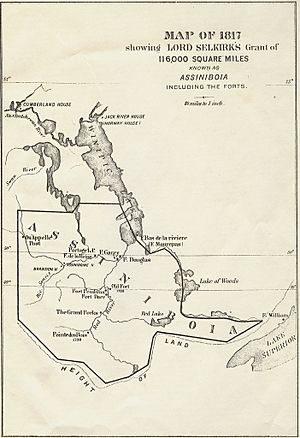Bas de la Rivière facts for kids
The Bas de la Rivière is a special place on both sides of the Winnipeg River. It is located right where the river flows into Lake Winnipeg. This area played a very important role in the early history of western Canada, especially during the fur trade and settlement periods.
Explorers like Jean Baptiste de La Vérendrye and Pierre Gaultier de La Vérendrye visited this area in 1733. They built Fort Maurepas on the Red River in 1734. They might have built a small structure at Bas de la Rivière around that time. A second Fort Maurepas was built there shortly after the first one on the Red River.
After a big war called the Seven Years' War, trade and business grew steadily in the Bas de la Rivière area. It became a busy place with a supply center, a fishing spot, and a farm. By 1775, a large village of Cree people lived there. Alexander Henry the elder traded in the area around that time. Some old records even call Fort Bas de la Rivière the main base for the North West Company in the Winnipeg River area during the times when fur trading companies competed fiercely.
Fur Trade Posts
The Bas de la Rivière area was home to three important posts: the second Fort Maurepas (built by the French around 1739), Fort Bas de la Rivière (built by the North West Company in 1792), and Fort Alexander (built by the Hudson's Bay Company before 1800). This location was very important for travel and trade. The Winnipeg River was the main route for people traveling east to Montreal. From Lake Winnipeg, you could go in many directions: southwest to the Assiniboine River, northwest to the Saskatchewan River (and from there to Lake Athabasca), or northeast up the Hayes River to Hudson Bay.
These forts were not typical trading posts where people collected furs. Instead, they were like storage centers. Goods were kept there for shipping in either direction. After about 1810, when pemmican (a special food made from dried meat, fat, and berries) started to be made in the buffalo country along the Assiniboine River, these posts stored it. This pemmican was used to feed the voyageurs (travelers and traders) on their long journeys to distant places like Lake Athabasca. Some farming also took place in the area. After the two big fur trading companies joined together in 1821, the Bas de la Rivière area became less important. This was because trade routes shifted from Montreal to York Factory on Hudson Bay.
Fort Maurepas
The second Fort Maurepas (Canada) was built around 1739. It was on the north side of the river. It was built by some of La Vérendrye's men as they expanded west from Lake Superior. We don't know exactly when it was left empty. It might have been abandoned when the French generally pulled back during the French and Indian War.
Fort Bas de la Rivière
Fort Bas de la Rivière was built in 1792 by Toussaint Le Sieur of the North West Company. It was on the south side of the river, about six miles below the old Fort Maurepas. Sometimes, people called it Le Sieur's Fort.
Fort Alexander
Fort Alexander was built before 1800 by the Hudson's Bay Company. It was very close to the North West Company post. One of the McKays founded it. Supplies for this fort came from Fort Albany, Ontario on James Bay. They traveled via the English River (Ontario). This trip took about 40 days in one direction and 80 days to return. In 1800, Alexander Henry the younger said that the post had a clerk and two men. He noted it was not making enough money to cover its costs.
When the two companies merged in 1821, the Hudson's Bay Company post closed. Its operations moved to the North West Company post, which was then renamed Fort Alexander. When Nicholas Garry visited the post in 1821, he saw that 50 women and children were living there, supported by the company.
There are mentions of another post built by the XY Company across the river from the North West Company post. Also, Jean Baptiste Adhemar had a post around 1780 on the Assiniboine River. He supplied travelers heading east with pemmican at a place called Pemmican Point, near the mouth of the Winnipeg River. A monument near Fort Alexander, Manitoba states that these forts were "nearby."


